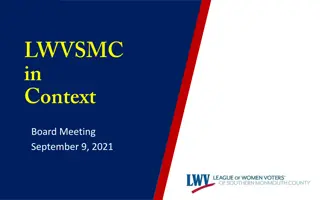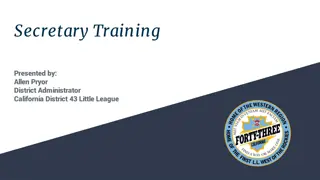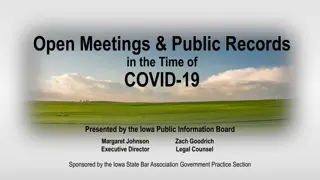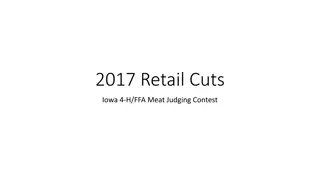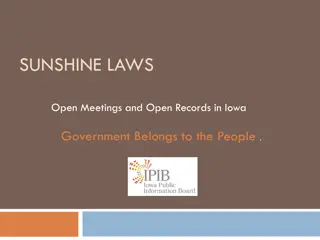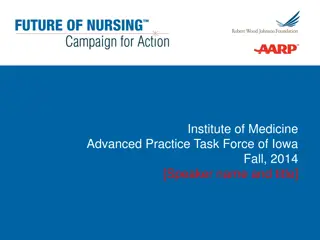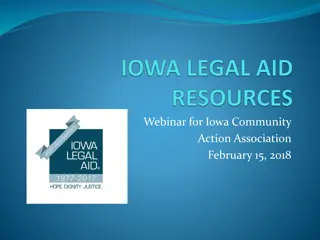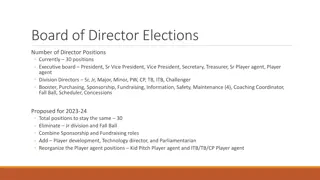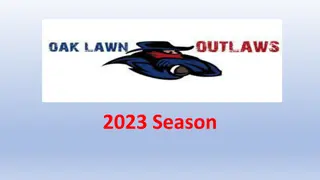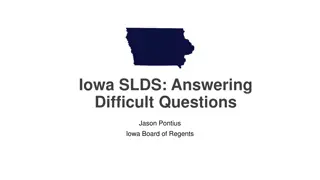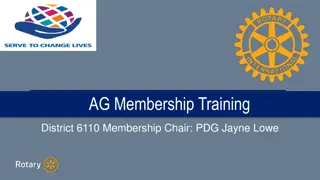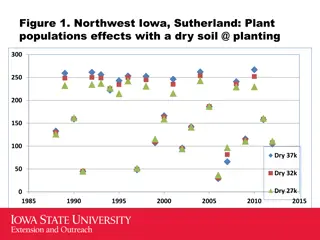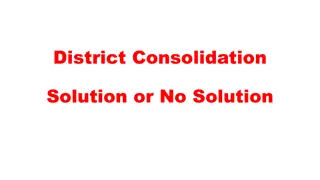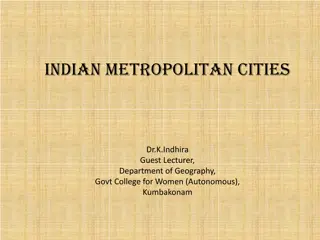Iowa League of Cities Membership Webinar June 28, 2023
The key highlights of HF 718 Property Tax Legislation discussed in the Iowa League of Cities Membership Webinar. Division II covers city rate consolidation and mechanisms for levy reduction based on growth triggers. The legislation also introduces homestead credit and exemption provisions for individuals aged 65 and over, aiming to streamline property tax management and ensure equitable taxation practices.
Download Presentation

Please find below an Image/Link to download the presentation.
The content on the website is provided AS IS for your information and personal use only. It may not be sold, licensed, or shared on other websites without obtaining consent from the author.If you encounter any issues during the download, it is possible that the publisher has removed the file from their server.
You are allowed to download the files provided on this website for personal or commercial use, subject to the condition that they are used lawfully. All files are the property of their respective owners.
The content on the website is provided AS IS for your information and personal use only. It may not be sold, licensed, or shared on other websites without obtaining consent from the author.
E N D
Presentation Transcript
HF 718: Property Tax Legislation Iowa League of Cities Membership Webinar June 28, 2023
Agenda City-Related Content of HF 718 High-level Summary & Impact Examples Division 2 Questions
Division II City Rate Consolidation Sets the max rate for this combined levy at $8.10 in future years Consolidates several General Fund levies and the Emergency levy into a combined general fund levy Provides a mechanism for levy rate to be reduced if non-TIF taxable growth triggers are met or exceeded Goal is to bring all levies back under or to the $8.10 max rate over time
Division II City Rate Consolidation (cont.) Regular General Emergency Contract for Use of Bridge Rent / Ins /Maint. Of Non-owned Civic Center Operation & Maint. of Owned Civic Center Planning of San. Disposal Proj. Levy Improv. Fund in Special Charter City Inst. / Vocal Music Groups Memorial Building Symphony Orchestra Cultural / Scientific Facilities County Bridge Border River Bridges Aid to Non-Gov Transit Company Maintain Gift/Devise Institution City EMS Support Public Library
Division II City Rate Ratchet Down (cont.) Provides a mechanism for levy rate to be reduced if non-TIF taxable growth triggers are met or exceeded Goal is to bring all levies back under or to the $8.10 max rate over time Reduces levy by constraining growth by 2% or 3% each year, depending on the trigger hit Non-TIF taxable growth under 3%, no reduction Non-TIF taxable growth over 3% but less than 6%, 2% reduction factor applied Non-TIF taxable growth over 6%, 3% reduction factor is applied
Calculation of Ratcheting Mechanism (Current Year CGFL requested dollars/(Current Year non-TIF taxable * reduction percentage))*1000 = Budget Year CGFL Rate Budget Year CGFL * (Budget Year non-TIF taxable/1000) = Budget Year CGFL revenue
Division V Homestead Credit & Exemption Retains the homestead credit and adds a homestead exemption for individuals 65 and over AY2023 an exemption of 3,250 AY2024 and forward, an exemption of 6,500 Requires the homestead credit form to allow for ability to claim exemption Requires those currently receiving the homestead credit to receive the homestead exemption without further application if they qualify (are 65 or over)
Division VI Military Exemption Increases the military exemption to 4,000 for AY23 / FY25 and after Current military exemption is 1,852 Division VIII Transit Funding Applies only to transit operators in cities over 200K in population Currently would only apply to the City of Des Moines & DART Allows Des Moines to continue to assess a franchise fee up to 7.5% Amount over 5% must be paid to DART and used to reduce DART levies Effective for FY25
Division VII Urban Revitalization Requires minimum assessment agreements on new commercial abatement agreements For Urban Revitalization which includes residential, allows the school rate (total rate) to apply to the abated residential value Only the school rate will apply, the property is still exempt from all other tax rates Effective for AY25 / FY27
Division X Budget Notice Mailing Process Requires cities, counties and schools submit the following information via DOM forms by March 15 beginning for FY 2024-2025 budgets: Total Current Year Tax Rate and Dollars (DOM Provides) Proposed Budget Year Tax Rate and Dollars If there is an increase, an explanation of the reasons for the increase, detailing specific purposes or programs An example of the tax impact on a residential and commercial property (DOM Provides) Percentage of current year property tax rate in relation to other levy authorities (DOM Provides) Time, Date and Place of hearing on this proposal Requires notice be published of this public hearing in the same manner as the regular budget notice. Requires it be placed on local government s web page and social media
Division X Budget Notice Mailing (cont.) Requires County auditor to mail the budget statements to taxpayers by March 20 Extends all local government budget deadlines to April 30 Extends deadline for budget protests to May 10 DOM will create the forms to be mailed and the system for cities to enter their information for the mailing
Division XIII & XIV City Debt Issuance Requires bond elections to be held on the regular November election date Effective for elections held after July 1, 2023 Requires statement on property tax impacts to essential & general corporate purpose bond issuance notice an estimate of the annual increase in property taxes as the result of the bond issuance on a residential property with an actual value of one hundred thousand dollars
Division XIII & XIV City Debt Issuance (cont.) Requires expanded debt reporting on the county and city Annual Financial Reports (AFRs) Full list of debts owed by city during the fiscal year Similar in nature to the Long Term Debt Schedule of the budget forms Amount of issue Purpose of the debt Approval via election or council vote Whether inside of non-voted issuance thresholds for General Corporate Purpose Date of issuance
Division XIII & XIV City Debt Issuance (cont.) Increases the thresholds for city debt issuances w/o vote 5,000 or less in population = $520,000 5,001 to 75K in population = $910,000 75,001 and above in population = $1,300,000 Requires DOM to recalculate and publish thresholds Adjusted by a CPI factor every January Beginning January 1, 2025 Requires DOM to issue a report on bond issuance to the General Assembly each December 1
Division IX County Auditor Valuation Reporting Requires county auditors to begin submitting a different breakdown of assessed and taxable valuation each November/December Revaluation property New Construction & Other property Effective for AY 2024 & FY 2025-2026
HF 718: Summary-Level ALL cities impacted Budget process will be a major change Division 2 (among others) will have impacts on financial considerations Changes to exemptions & credits will have impact on city taxable valuations Elections for bonds for indebtedness restricted to one annual timeline Thresholds for bond requirements for general corporate purpose increased Property tax abatement agreements and limits
HF 718: Summary-Level (Division 2): ACGFL levies will be impacted for most communities: From LSA s Fiscal Note: 96% of cities experienced at least one year of [tax base] growth above 3% from FYs 17-23 A significant majority can expect to see their property tax rate trimmed for at least one of the upcoming four years
HF 718: Division 2 City Examples City A Assumptions: medium-growth city Line 2a valuation (FY 24): $1,000,000,000 Line 2a valuation (FY 25): $1,040,000,000 Assume FY 24-25 growth: 4% (Tier II) FY 24 ACGFL (baseline): $8.10 Formula to derive FY 25 ACGFL maximum: 1,000 * (Property taxes generated in previous year by ACGFL / (1.02*Line 2a valuation in previous year) = 1,000*($8.10*($1,000,000,000/$1,000))/ (1.02*$1,000,000,000) =1,000*($8,100,000/$1,020,000,000) =$7.94 (for FY 25) The math If City A had 4% growth the following year(s): FY 26 ACGFL = $7.78 FY 27 ACGFL = $7.63 FY 28 ACGFL = $7.48 *FY 29+ can go up to $8.10 max ACGFL for ALL cities
HF 718: Division 2 City Examples Impact of revenue generated by City A Pre-HF 718: assume ACGFL-equivalent rate stayed at $8.10 Generates ~$35.8M (FYs 25-28 combined) With assumed HF 718 rates (previous slide) Generates ~$34.0M (FYs 25-28 combined) Year-to-Year Difference is about a 2% reduction each of the 4 years Difference is about 9.4% if amount in FY 28 is compared alone Difference in 4-year totals is about 5.2% *Important Note: this example assumes the city used the new max calculated ACGFL each year. Cities can choose a ACGFL lower than the calculated max. It also assumes the Tier II growth rate each year (3-6% Line 2a valuation growth). If the city fell below 3%, and had a ACGFL rate under $8.10, it could go up to the new $8.10 limit for that year.
HF 718: Division 2 City Examples City B Assumptions: low or no growth city Line 2a valuation (FY 24): $50,000,000 Line 2a valuation (FY 25): $50,000,000 Assume growth: 0% (Tier I) for all budgets FYs 25-28 FY 24 ACGFL (baseline): $8.50 City B can go up to $8.50 max ACGFL levy for each budget FY 25-28. In FY 29, City B will be subject to a $8.10 max ACGFL (as are all cities) The impact for FYs 29 and forward would depend upon the starting ACGFL.
HF 718: Division 2 City Examples City C Assumptions: high-growth city Line 2a valuation (FY 24): $3,000,000,000 Line 2a valuation (FY 25): $3,210,000,000 Assume FY 24-25 growth: 7% (Tier III) FY 24 ACGFL (baseline): $8.37 Formula to derive FY 25 ACGFL maximum: 1,000 * (Property taxes generated in previous year by ACGFL / (1.03*Line 2a valuation in previous year) = 1,000*($8.37*($3,000,000,000/$1,000))/ (1.03*$3,000,000,000) =1,000*($25,110,000/$3,090,000,000) =$8.13 (for FY 25) The math If City C had 7% growth the following year(s): FY 26 ACGFL = $7.89 FY 27 ACGFL = $7.66 FY 28 ACGFL = $7.44 *FY 29 can go up to $8.10 max ACGFL for ALL cities
HF 718: Division 2 City Examples Impact of revenue generated by City C Pre-HF 718: assume ACGFL-equivalent rate stayed at $8.37 Generates ~$119.3M (FYs 25-28 combined) With assumed HF 718 rates (previous slide) Generates ~$110.6M (FYs 25-28 combined) Year-to-Year Difference is about a 3% reduction each of the 4 years Difference is about 11.1% if amount in FY 28 is compared alone Difference in 4-year totals is about 7.3% *Important Note: this example assumes the city used the new max calculated ACGFL each year. Cities can choose a ACGFL lower than the calculated max. It also assumes the Tier III growth rate each year. If the city fell below 3% for Line 2a valuation growth, and had a ACGFL rate under $8.10, it could go up to the new $8.10 limit for that year.
HF 718: Resources League website & summary-level Cityscape article/info sheet League s New Laws publication Department of Management Webinar Upcoming events League Budget Workshops Update to special report on property taxes *anticipated fall/winter 2023
Thank you! Ted Nellesen Iowa Department of Management ted.nellesen@iowa.gov Erin Mullenix Iowa League of Cities erinmullenix@iowaleague.org





